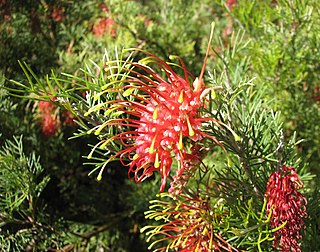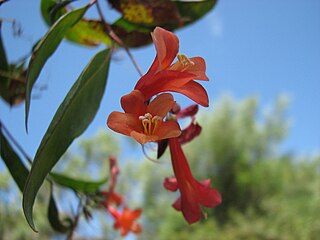
Grevillea thelemanniana, commonly known as spider net grevillea, is species of flowering plant in the family Proteaceae and is endemic to Perth, Western Australia. It is a spreading shrub with linear and pinnatipartite to pinnatisect leaves with linear to narrowly elliptic lobes, and clusters of 6 to 14 pinkish-red and cream-coloured flowers with a red, green-tipped style.

Grevillea vestita is a species of flowering plant in the family Proteaceae and is endemic to the southwest of Western Australia. It is an erect, spreading, prickly shrub with lobed leaves, the number and arrangement of lobes depending on subspecies, and more or less spherical to dome-shaped clusters of hairy, white to cream-coloured flowers sometimes tinged with pink.

Thomasia macrocarpa, commonly known as large-fruited thomasia, is a shrub that is endemic to the southwest of Western Australia.

Marianthus erubescens is a species of flowering plant in the family Pittosporaceae and is endemic to the southwest of Western Australia. It is a woody, glabrous shrub or climber, with narrowly elliptic leaves and down-curved, red flowers arranged groups of three to six.
Dasymalla axillaris, commonly known as native foxglove or woolly foxglove, is a flowering plant in the mint family Lamiaceae and is endemic to Western Australia. It is a small, diffuse shrub with its branches, leaves and some of its flower parts densely covered with white, woolly hairs. The flowers are a shade of red and tube-shaped with the stamens and style extending beyond the end of the five petals.

Thelymitra flexuosa, known as the twisted sun orchid, is a species of orchid that is endemic to southern Australia. It has a single thin, wiry leaf and up to four cream-coloured to canary yellow flowers with four rows of short hairs on the back of the column. It is a common and widespread species, superficially similar to T. antennifera.

Lasiopetalum bracteatum, commonly known as Helena velvet bush, is a species of flowering plant in the family Malvaceae and is endemic to the south-west Western Australia. It is an erect, spreading shrub with egg-shaped leaves and loose groups pinkish flowers.

Conostylis candicans, commonly known as grey cottonheads, is a flowering plant in the family Haemodoraceae and is endemic to the south-west of Western Australia. It has grey foliage and bright yellow flower heads.

Billardiera floribunda, commonly known as white-flowered billardiera, is a species of flowering plant in the family Pittosporaceae and is endemic to the south-west of Western Australia. It is a robust twining shrub or climber that has thick, leathery, elliptic leaves and white or pinkish flowers arranged in groups of ten or more.

Marianthus bicolor, commonly known as painted marianthus, is a species of flowering plant in the family Pittosporaceae and is endemic to the southwest of Western Australia. It is a low, erect, spreading shrub or climber with narrowly elliptic leaves and white to cream-coloured flowers with maroon or purple striations flowers arranged in branched clusters.

Johnsonia acaulis is a plant in the family Asphodelaceae and is endemic to the south-west of Western Australia. It is a rhizomatous, tufted, or grass-like perennial with white, pink or green flowers.

Conostylis bracteata is a tufted perennial plant in the family Haemodoraceae and is endemic to the south-west of Western Australia. It is a rhizomatous, tufted, perennial, grass-like plant or herb with flat leaves and yellow, hairy, tubular flowers.

Conostylis canteriata is a rhizomatous, tufted perennial, grass-like plant or herb in the family Haemodoraceae and is endemic to the south-west of Western Australia. It has stilted roots, flat leaves, and pale lemon-yellow tubular flowers.

Johnsonia teretifolia, common known as hooded lily, is a plant in the family Asphodelaceae and is endemic to the south-west of Western Australia. It is a rhizomatous, tufted, or grass-like perennial with white, pink or green flowers.

Conostylis caricina is a flowering plant in the family Haemodoraceae and is endemic to the south-west of Western Australia. It is a rhizomatous, tufted perennial, grass-like plant or herb with flat leaves and heads of 6 to 8 creamy-yellow flowers.

Conostylis crassinerva is a rhizomatous, tufted perennial, grass-like plant or herb in the family Haemodoraceae and is endemic to the south-west of Western Australia. It has flat leaves and yellow tubular flowers that turn reddish as they age.

Conostylis deplexa is a rhizomatous, tufted or solitary perennial, grass-like plant or herb in the family Haemodoraceae and is endemic to the south-west of Western Australia. It has flat leaves and uniformly yellow, tubular flowers.

Conostylis drummondii is a rhizomatous, tufted perennial, grass-like plant or herb in the family Haemodoraceae and is endemic to the south-west of Western Australia. It has short stems, and has more or less cylindrical leaves and pale lemon-yellow flowers.

Conostylis festucacea is a rhizomatous, tufted or proliferous perennial, grass-like plant or herb in the family Haemodoraceae, and is endemic to the south-west of Western Australia. It has cylindrical or flat leaves and yellow flowers.

Conostylis hiemalis is a rhizomatous, tufted perennial, grass-like plant or herb in the family Haemodoraceae and is endemic to the south-west of Western Australia. It has flat leaves, usually with woolly grey hairs at the base, and pale yellow to cream-coloured, tubular flowers.




















